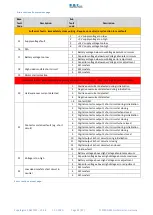
SuperSigma2 AM PMS
–
V1.5.6 17-1-2020
Page 76 (97)
©2019 DMC GmbH Herten Germany
Insulation class
Maximum allowable operation
temperature
T
max
[°C]
Allowable temperature
rise
T
rise
[°C]
A
105
60
B
130
80
F
155
105
H
180
125
Nominal motor current
A motor is usually constructed according to an insulation class. Also, the motor is rated a ‘nominal current’. When the
motor has a temperature equal to the ambient temperature and starts to run, it will be heated up proportional with the
current flowing through the motor.
By definition, when the current flowing through the motor is equal to the nominal rated current, the motor temperature
will rise to a temperature which is equal to the maximum allowable operation temperature for that insulation class.
Example
•
Insulation class of the motor:
F
•
Nominal current of the motor:
100 A
•
Ambient temperature:
40 °C
When the motor is running continuously for an infinite time, the motor temperature will rise to a temperature of 155 °C
and will stabilize there. See also the graph below.
Cooling
Of course, cooling will have an influence in the maximum allowable operation temperature. It may happen that with
sufficient cooling the maximum allowable operation temperature is not reached. Or, in a worse case, the temperature
rises
beyond
the maximum allowable operation temperature. In that case, the user must make sure there is enough
cooling (e.g. increase in air flow, water cooling, etc.).
The factor time
The allowable temperature rise is thus a known value. The
rise
time
in which the motor temperature has increased this
amount is an important factor. This time depends on the cooling characteristics (e.g. type and amount of cooling) of the
motor.
By definition, the
rise time
is that time in which the motor temperature rises from the reference (ambient) temperature
to the maximum allowable operation temperature when the motor is drawing a constant current which is twice the
nominal rated current of the motor.
This rise time must be measured or calculated.
50
100
150
Time
Temperature
95 %
155 °C






























